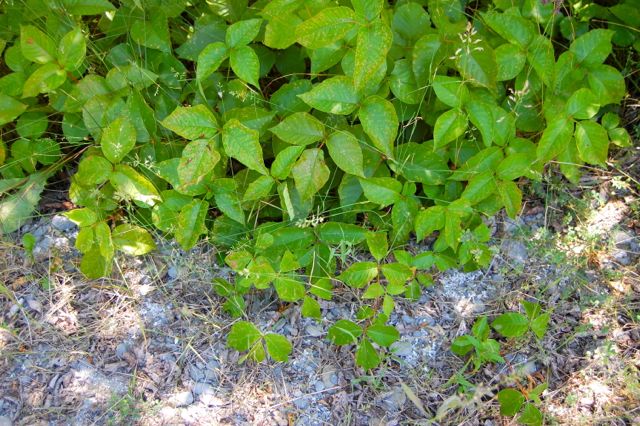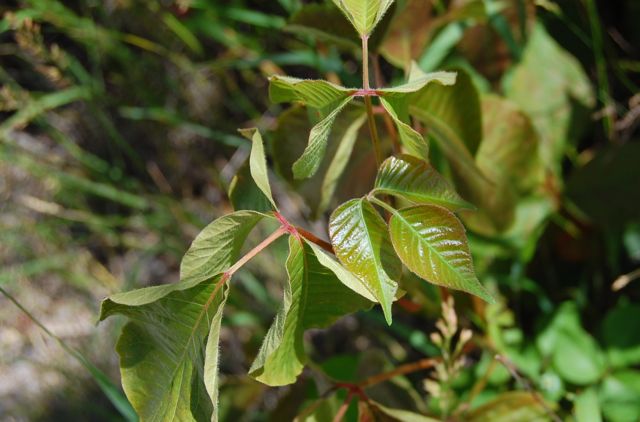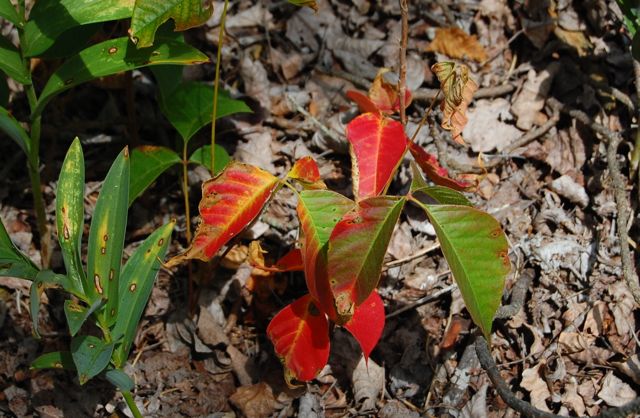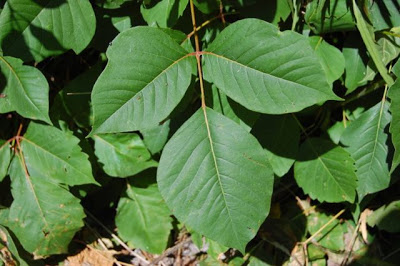| Poison Ivy (Toxicodendron radicans) – “leaves of three, let it be.” |
Hiking with Mr. TG last weekend, it became clear that my former- Scoutmaster husband had forgotten what poison ivy (Toxicodendron radicans) looks like. Yikes. And it was everywhere along our path.
One study suggests that poison ivy might get itchier and more plentiful in our changing atmosphere. Here’s what to watch out for.
Poison ivy has a compound leaf with three leaflets, the centre one having a long stalk. This is key. Note that in all the images here.
Beyond that, plant characteristics can be quite variable, which can make it hard to spot. For example, the leaf margins or edges can be smooth, such as the biggest leaf in the photo above, or toothed, such as some of the smaller leaves behind it. The plant can grow as a low groundcover, just at about itchy ankle height, but can also grow with an upright, shrublike habit and can even climb trees as a vine. Walter Muma’s Ontario Wildflowers website has an excellent set of illustrative images and info.
His Ontario Trees & Shrubs site offers equally good info on Poison Sumac (Toxicodendron vernix) as well as Poison Ivy’s non-toxic lookalike cousin Fragrant Sumac (Rhus aromatica), a native shrub with excellent red fall colour. In fact, Toronto has extensive plantings of fragrant sumac bushes along the eastern Lakeshore Avenue and Leslie Street sections of the Martin Goodman Trail.
Not everyone is susceptible to the allergens in poison ivy. As many as 3 in 10 are unaffected. If you find yourself with the characteristic wavy-lined rash that seems to grow, then you might have come into contact. Here’s Health Canada’s advice about what to do.
If you find it on your property, you can control it with pesticides such as Round-Up (never burn poison ivy!) – one of the few cases when homeowners can use pesticides under Ontario’s Pesticide Ban. (Here is David Suzuki’s plain-language summary of the Pesticide Ban.)
 |
| As a ground-hugger, Poison Ivy likes to grow at the edges of paths. Keep your eyes open for those stray plantlets. |
 |
| Often, the leaflets droop downward and seem almost folded at the centre. New leaves contain the strongest irritants. |
 |
| Stressed or autumn leaves show their cousin-ship to the sumac family by turning a bright red. |
Poison Ivy was formerly classed in the same family as its cousin the staghorn sumac (Rhus typina) and known as Rhus toxicodendron – “toxicodendron” means “toxic leaves” – or Rhus radicans. All are in the cashew family, and a surprising distant cousin of the mango!
[UPDATE:] If you’d like to hear further tips on Poison Ivy, and hear a delightful Alabaman accent, listen to this short podcast from Backyard Wisdom. A few details don’t apply; for example, poison oak isn’t found in our Northern climes. However, tips on how to deal with exposure are quite useful.






8 comments
It's also useful to know that every part of the plant, including the roots, are poisonous to the affected. I got a terrible poison ivy rash in the 1970s after a fall weekend working the soil at our new house in preparation for seeding the lawn. At some point in my digging, I stopped and rubbed my eyes; a few days later, both eyes were swollen shut. Not a happy memory. -Jean
So many things to comment on….Have Mother in Law visiting right now and she is VERY allergic to poison ivy. Yesterday she had a 'mysterious' rash with tiny water blisters pop up on her forehead. We think she had some poison ivy oils on her hat (sunhat) that she wore the day before. Attacking the rash aggressively. As we took our walk with the dogs she asked about the Sumac we have here,Rhus copallina or Winged Sumac. She was worried about it being poison sumac.
As for the cashew family and mangoes….my daughter had a bad outbreak on her lips and chin… turned out she ate a mango over the sink, from the skin, with the juice running down her chin and arm. Did a posting about it.
Great post!!
It is such a pretty thing and so tough. That is the problem and the fact that I am allergic to it. It loves my gardens so I have to constantly be on the prowl. In fact I need to go spray some now.
We are surrounded by poison ivy with living in the middle of woods. We had vines as large as our arms! We don’t know why the previous homeowners never eradicated it from the property. The Saint put on his coveralls and heavy duty gloves and sawed through the vines at the base of the trees. Then we let nature take its course and it has slowly died over the years. We are super careful around the stuff but at times we get into it. Luckily for us, we do not seem to be allergic to it. Although, The Saint did have a reaction after pulling roots of the ivy unbeknownst to him. With sweat running off his brow, he wiped his eyes. A trip to the Doctor was in store for that mistake. But the meds immediately worked for his itch and pain. All was good again and we keep a eye on the woods for new vines…
Oh, I forgot to mention, I have a brother that if he is anywhere near the stuff he has a awful reaction…..
you've got to be joking … using Roundup or anything from Monsanto for that matter!
I'm certainly no fan of Monsanto, and in fact am strongly opposed to large-scale use of Roundup or "Roundup Ready" seed. However, poison ivy control is one instance where limited use of glyphosate (the active ingredient) might be warranted.
We have poison ivy in our area but I've never really known just what it looked like. Thanks for the great photo!